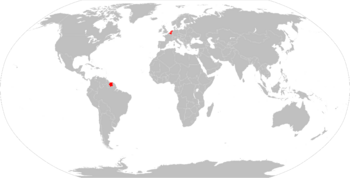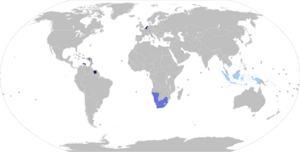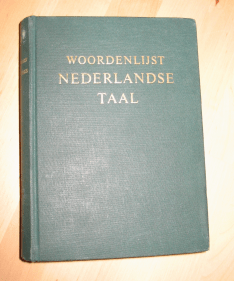Dutch Language Union facts for kids
Quick facts for kids
Nederlandse Taalunie
Dutch Language Union
|
|
|---|---|

A map showing the member states of the Dutch Language Union (red)
|
|
| Headquarters | The Hague, Netherlands Brussels, Belgium |
| Official language | Dutch (Standard Dutch) |
| Membership | |
| Leaders | |
|
• Secretary-general
|
Kris Van de Poel |
| Establishment | |
|
• Treaty
|
9 September 1980 |
| Population | |
|
• 2022 estimate
|
~25 million |
The Dutch Language Union (Dutch: Nederlandse Taalunie [ˈneːdərlɑntsə ˈtaːlˌyni], NTU) is an international group that helps manage everything about the Dutch language. It is most famous for changing spelling rules, publishing grammar books, and creating the "Green Booklet." It also supports Dutch language classes and studies around the world.
The Union was started by a special agreement between the Netherlands and Belgium on September 9, 1980. Later, Suriname joined as a partner in 2004.
Contents
How the Dutch Language Union Started
The Dutch Language Union was officially created when Belgium and the Netherlands signed a treaty in Brussels on September 9, 1980. This new agreement took the place of an older "Cultural Agreement" between the two countries from after World War II.
In 1995, after Belgium changed its government structure, a new treaty was signed between the Netherlands and Flanders (the Dutch-speaking part of Belgium). On December 12, 2003, Suriname also signed an agreement to join the Union. Suriname's government approved this in 2004, and it became official in 2005.
What is Standard Dutch?
Standard Dutch (called Algemeen Nederlands, or AN) is the official version of the language. It is what is taught in schools and used by governments in the Netherlands, Flanders, Suriname, and the Dutch Caribbean. The Dutch Language Union decides what counts as AN.
The older name for Standard Dutch was Algemeen Beschaafd Nederlands, which meant "Common Civilised Dutch." This name suggested that other ways of speaking Dutch were not "civilised." To avoid this, the name was changed to Algemeen Nederlands, which simply means "General Dutch."
The Official Word List
One important thing the Dutch Language Union did was change Dutch spelling rules in 1995. This change mainly affected how certain parts of words were written in compound words.
The Union publishes a very famous book called the Woordenlijst Nederlandse taal. Most people know it as the "Groene boekje" or "Green booklet" because of its green cover. This Green Booklet is the official guide for Dutch spelling and grammar. It lists words and shows their correct spelling and plural forms, but it does not give word definitions.
The newest Green Booklet came out on October 13, 2015. Its content is the same as the 2005 version. The 2005 version had some spelling changes that were not very popular because they changed some rules from 1996 again. In December 2005, many Dutch news companies decided not to use the new rules. In August 2006, they released their own "White book" with slightly different guidelines.
Today, both the "green" and "white" spellings are used, which can sometimes be confusing. Schools and government offices use the "green" spelling, while newspapers, magazines, and TV stations often use the "white" one. In Belgium, however, the spelling changes were generally accepted without problems.
Dutch Dictionaries
The Van Dale dictionary is widely considered the most important Dutch dictionary. It is often called the Dikke Van Dale ("Thick Van Dale") because it is so big. This dictionary comes in three parts and is usually updated every 7 to 8 years. The 15th edition was published on September 23, 2015.
The Woordenboek der Nederlandsche Taal (WNT) is a huge historical dictionary. It includes all Dutch words used from the year 1500 up to today. Work on this dictionary started in 1864 and was finished in 1998 when the last volume was published. It has 46 volumes and takes up about 3 meters of shelf space. It contains about 400,000 words on nearly 50,000 pages. In 2001, three more volumes were added with words from the 20th century that were not in the earlier parts. You can find this dictionary online.
Learning Dutch as a Foreign Language
The Dutch Language Union helps teach Dutch in schools in nearby countries. This includes parts of Belgium (like Brussels and Wallonia), where about 350,000 people learn Dutch. In Germany (Lower Saxony and North Rhine-Westphalia), about 40,000 people learn Dutch. In France (Nord-Pas-de-Calais), about 8,000 people learn Dutch.
The Union also supports the study of the Dutch language and culture at universities and schools worldwide. Around 14,000 people study Dutch language and literature at 140 different places around the globe.
How the Dutch Language Union Works
The Dutch Language Union (NTU) has offices in The Hague (Netherlands) and Brussels (Belgium). It is made up of four main parts:
- The Secretariat-General: This group prepares and carries out the Union's plans. Kris Van de Poel has been its leader since March 2020.
- The Committee of Ministers: This group includes the ministers of education and culture from the Netherlands and Flanders.
- The Interparliamentary Commission: This group is made up of members from the Dutch and Flemish parliaments.
- The Council for Dutch Language and Literature: This group consists of experts in the Dutch language and literature.
Important Institutes
Instituut voor de Nederlandse Taal
The Instituut voor de Nederlandse Taal ("Institute for the Dutch Language") is located in Leiden. It works under the Dutch Language Union and is responsible for the Woordenboek der Nederlandsche Taal (Dictionary of the Dutch language). The institute also publishes other dictionaries, like the Old Dutch Dictionary and the Early Middle Dutch Dictionary. They also create databases, including ones that index newspapers, magazines, and legal documents. The Spoken Dutch Corpus has recordings of modern Dutch spoken in the Netherlands and Flanders.
Royal Academy of Dutch Language and Literature
The Royal Academy of Dutch Language and Literature was started in Belgium in 1886. Its goal is to promote the culture and literature of Flanders. It gives official advice to the Flanders government. It also publishes the Materiaal Willems database, which contains information about different Dutch dialects.
Connections with Other Countries
The Dutch Language Union also handles how the Netherlands and Flanders work with other countries regarding language. It is active in Indonesia and South Africa, two countries that have historical ties to the Dutch language. In South Africa, the cooperation is not just about the Afrikaans language, but also about encouraging many languages to be used.
The Union's main goals are focused on the Dutch language and literature. Its work is not as broad as groups like the Community of Portuguese Language Countries or the La Francophonie.
The treaty that created the Dutch Language Union allows for its work to be extended to other parts of the Kingdom of the Netherlands outside Europe. The main groups within the Union are the Committee of Ministers, the Secretariat-General, the Interparliamentary Committee, and the Dutch Language and Literature Council. Suriname also has special ways to take part in the Union's activities.
Countries in the Union
The Dutch Language Union is based on a treaty between the Kingdom of the Netherlands and the Kingdom of Belgium. These two countries are the main members. For the Kingdom of the Netherlands, the treaty only applies to its European territory.
The treaty allows for two ways to expand:
- Other independent countries can join as "associate members."
- The Union's work can be extended to other parts of the Kingdom of the Netherlands, such as Aruba, Curaçao, Sint Maarten, and the Caribbean Netherlands.
In 2004, Suriname signed an "associative treaty" with the Union. Since November 27, 2013, the treaty also applies to the Caribbean Netherlands. The three self-governing Caribbean countries of the Kingdom of the Netherlands—Aruba, Curaçao, and Sint Maarten—are considered possible future members. Also, Indonesia and South Africa are seen as "special partners" of the Dutch Language Union.
Awards and Prizes
Since 1986, the Dutch Language Union has managed the Prijs der Nederlandse Letteren (Dutch Literature Prize). This important award is given every three years to a writer from the Netherlands, Belgium, or Suriname. It is one of the most respected awards in Dutch literature.
Another literary award managed by the Dutch Language Union is the Toneelschrijfprijs for playwrights (people who write plays).
See Also
- Dutch orthography
- List of language regulators
- OpenTaal
- Digital Library for Dutch Literature



